Human Capital
Our Human Capital is pivotal to our success making talent management a business priority. We have honed our abilities to attract, nurture and retain talent through policies and governance structures that balance divergent interest of employees and other stakeholders as evinced by a 95% retention rate and employee productivity rates that are the highest in the industry. This is how we do it.

Strong HR Governance
The Board recognises its responsibility for our People Strategy and the BHRRC assist them in discharge of their duties.
A comprehensive policy framework clearly outlines the Bank’s approach to managing Human Capital while a Code of Ethics clearly defines expectations of employees. The HR Department is responsible for implementing the people strategy and continuously improves its processes and procedures to strengthen employee value creation processes. The Board, BHRRC and the CEO receive regular reports on key performance indicators to assess the progress and effectiveness of the HR function. Compliance with all regulatory requirements at all locations is a sine qua non and we seek to go well beyond this base requirement in managing our considerable talent pool.
Our Team
A 4,987 strong-team comprising a diverse mix of individuals are the primary value creators for the Bank. As an equal opportunity employer, our team represents both genders, all major ethnic groups in the country and generations X, Y and Z who work together in a conducive environment with dignity and mutual respect. Our retention rates and employee satisfactions scores are testimony to the high levels of engagement within the team. Overseas employees now number 279, an increase of 2.95% over 2015 as we grow our international operations. During the year, we promoted 371 employees, helping them realise their career goals. We recruited 271 new employees to the talent pool with responses affirming our ability to attract talent. Long service awards given to 73 employees who completed 25 years of service at a special ceremony, which is now an annual event. Their careers serve to inspire younger employees as it is the most eloquent testimony to how we create value for employees.
Employees are typically engaged on full-time employment contracts with a few on contracts where the need is likely be for a specific time. We also use outsourced employees for specific functions which are non-critical.
The following graphs provides testimony to our teams diversity and strength. (Graph 22 to 25).
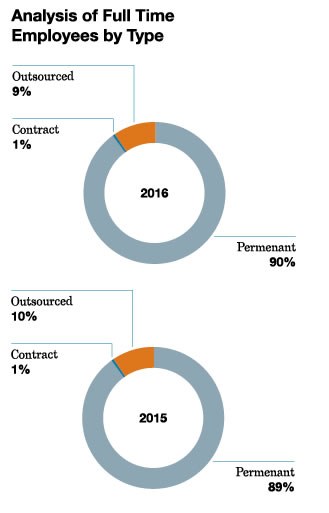
Graph 22
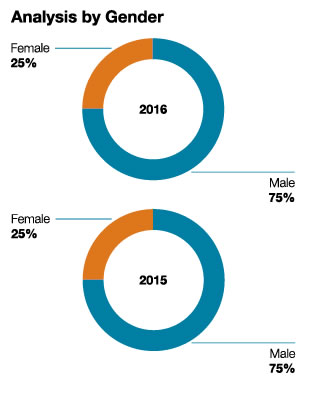
Graph 23
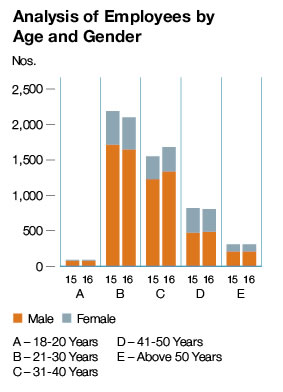
Graph 24

Graph 25
Creating Value for Employees
Building human and intellectual capital is intrinsically linked to employee retention and attraction. To attract and retain employees, we have to deliver value in numerous ways and create a great place to work where employees are inspired and motivated to perform at their optimum. HR policies are carefully framed to create a conducive environment that inspires high levels of performance and motivates employees to realise their potential. High levels of employee engagement and regular dialogue with the employee associations and grievance mechanisms enable us to identify employee concerns and address them effectively.

Figure 17
Employee Productivity
As evinced from the charts below (Graphs 26 and 27), employee productivity has consistently increased both in terms of revenue per employee and profit per employee due to initiatives on lean management and increasing digitisation. It is a key strength of the Bank and a tribute to the effectiveness of the training and development programmes and high levels of engagement.
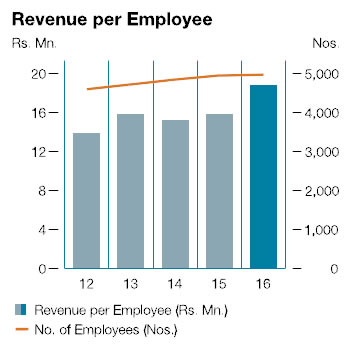
Graph 26
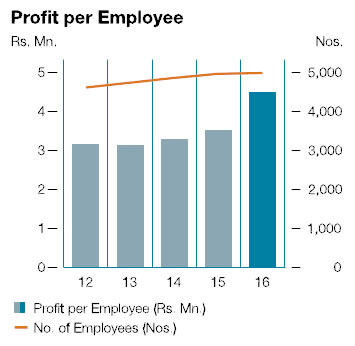
Graph 27
Talent Acquisition
We recruit employees based on objective criteria applied in a consistent manner to select the candidate best suited for the Bank’s business needs in accordance with our equal opportunity policy. Preference is given to local talent in the countries we operate in, facilitating integration in to the local communities. Most employees are recruited as Banking Trainees many of whom reach positions of leadership through training, development and other career progression initiatives. Preference is given to internal talent pools whenever vacancies occur although specialised skills are brought in at required levels if internal talent is not available. A policy of secondment to other countries ensures that the Commercial Bank culture and values are integrated in to our overseas operations as well, supplementing local recruitment. Orientation programmes for all new recruits also serve to ensure familiarisation with the organisations values, policies and procedures.
During the year, we recruited 271 employees of which 17% were females. Analysis of new hires by employment category, geography and age are provided in the graphs 28, 29 and 30.
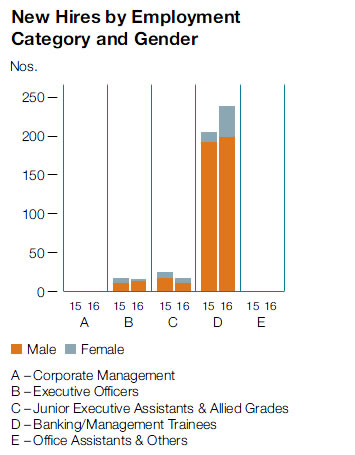
Graph 28
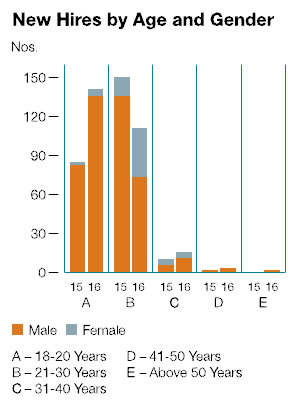
Graph 29
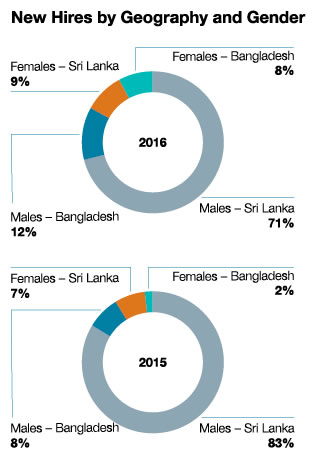
Graph 30
Training and Development
Training and Development is a key priority for the Bank enhancing knowledge, competencies, skills, attitudes and performance. A policy of giving preference to promote internal candidates and a transparent promotions process encourage both performance and self-development within the Bank. The Bank has a history of producing its own leaders who have progressed in their careers from trainees positions and serve as testimony to our Training and Development function. A learning culture where people are encouraged to continuously acquire knowledge, competencies and develop skills under the guidance of experienced mentors serves as the foundation for talent development at the Bank.
The Bank’s Staff Development Centre (SDC) offers a wide range of courses with internal and external resource persons catering to technical, leadership and soft skills training on a regular basis. Training needs identified alongside the performance evaluation process are considered when determining the internal course schedules which are supplemented with external courses where deemed necessary. Employee assessments based on written and oral examinations for promotions within non-executive and executive grades reinforces the need for continuous self-development and structured career development.
Employees have the opportunity to participate in a wide range of activities (Figure 18). The Bank also supports the mentoring and supervision requirements of professional bodies and is an approved employer for The Institute of Chartered Accountants of Sri Lanka and Institute of Bankers of Sri Lanka an acknowledgement of high standards of training and development.
Lifelong learning is supported by the Bank through payment of honorarium for completion of Banking studies at the Institute of Bankers of Sri Lanka, and reimbursement of membership fees of professional bodies.
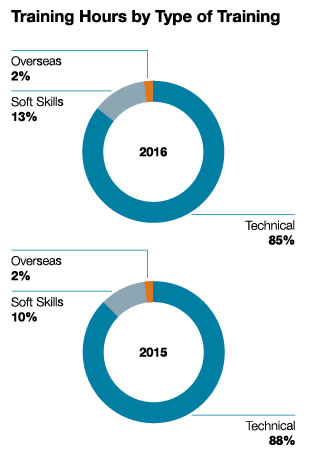
Graph 31

Graph 32
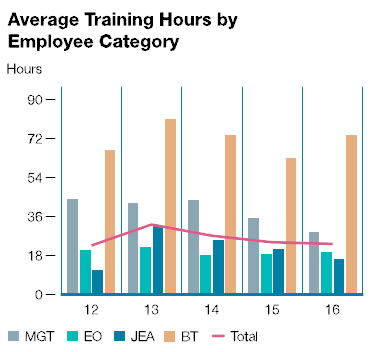
Graph 33
Employee Remuneration and Benefits
The Bank maintains an unbiased remuneration structure designed to compensate employees’ contributions and reward performance facilitating high levels of motivation and retention. Remuneration is made up of guaranteed pay and performance-based variable pay to encourage high levels of productivity.
Guaranteed pay and benefits are determined with reference to periodic market surveys conducted in Sri Lanka and Bangladesh to identify trends in the banking and mercantile sectors. Further, in Sri Lanka, collective agreements that cover specific employee categories are taken into consideration. Executive officers including Executive Directors receive incentives for performance vis-a-vis mutually agreed benchmarks which is linked to the performance appraisal system and a defined reward matrix. Employees who serve overseas as Business Promotion Officers and Bank's Representative Officers seconded to the countries we operate in receive remuneration linked to comparable roles in Sri Lanka supplemented by an allowance to cover expenses incurred abroad. The ratio of basic salary and remuneration of women and men at all locations of operation and across all employee categories is 1:1.

The out-sourced labour is contracted through reputed labour supplying companies and the Bank ensures that they are remunerated according to regulatory requirements including remittance of Employees‘ Provident Fund and Employees’ Trust Fund contributions.
Full-time employees receive the following benefits:
- Bonuses based on performance or decided on the collective bargaining agreement.
- Employee share option scheme for executive staff.
- Over time for work hours beyond stipulated work hours for non-executive staff
- Fuel allowance, transport allowances, entertainment allowance and for certain staff categories the reimbursement
of expenses incurred in performing official duties. - Accommodation/house rent and/or subsidised transportation or special allowances for employees working
at remote locations. - Medical benefits including a special coverage for surgical and hospitalisation, spectacles, dentures, hearing aid for staff and immediate family, annual health check-up for staff and spouse.
- Financial support for employees who are having disabled children, in order to cover their routine medical expenses.
- Group life cover extended for permanent employees who are not eligible for pension.
- Retirement benefits and commuted pension.
- Honorarium payment for employees who successfully complete the Diploma in Banking at the Institute of Bankers of Sri Lanka and reimbursement of annual subscription of professional bodies.
- Staff loans at below-market interest rates.
- Holiday bungalows and holiday allowances.
- Critical illnesses and personal accident insurance scheme.
Employee Retention
The Bank’s non-discriminative culture, remuneration and benefits, training and development, high levels of employee engagement and numerous other factors have proven to be successful for its track record of employee retention as shown in the graphs 34 to 38.
Employment separation processes are fully compliant with applicable labour laws of the countries that we operate in and reasons for exit are tracked and monitored. During the year the Bank bid farewell to 191 (4%) and 38 (15%) employees in Sri Lanka and Bangladesh respectively. An analysis of employee exits during the year is given below. Relatively high attrition rates in employees below 30 years of age are attributable to economic migration as they seek employment overseas and other opportunities according to feedback from exit interviews conducted with all employees who resigned.
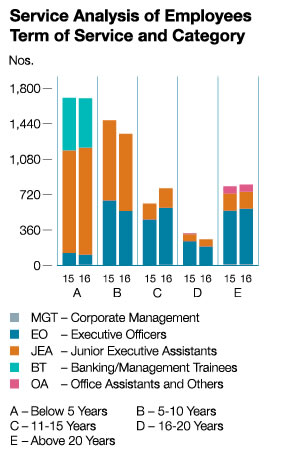
Graph 34

Graph 35
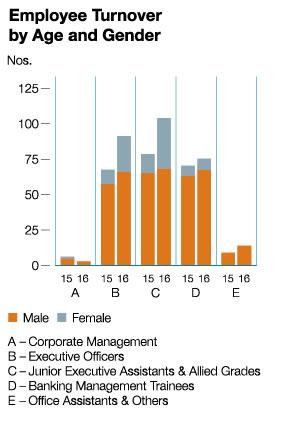
Graph 36
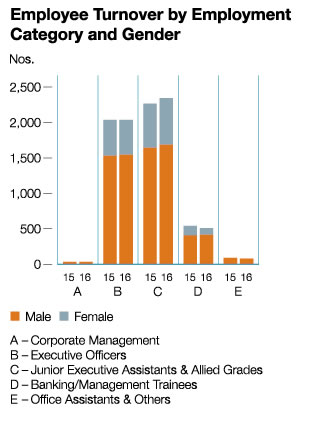
Graph 37

Graph 38
Equal Opportunity and Diversity
Equal opportunity policies ensure that objective criteria irrespective of gender, age, race or religion for recruitment and career progression openings. We monitor several key indicators to track progress towards our diversity goals set out in the Team Profile on page 70.
- Gender – Female representation on our team is lower than in the national labour force despite our commitment to gender diversity. Transferability within our wide network of branches deter females at recruitment and later, in career progression. Cultural conventions present significant impediments to women and while we wish to provide every opportunity, business needs of the Bank remain paramount in selecting appropriate candidates for vacancies. We are encouraged by the 98% (average of five years to 2016) of employees returning from maternity leave and those who remain in employment one year after returning to work and continue to make every effort to provide opportunities for women.
- Age – As we seek to nurture leaders from within, it is predictable that we have fewer recruits at senior management levels and that leadership positions are held by seasoned professionals who have a well-rounded experience in numerous aspects of banking.
- Ethnicity – We have representation from all major ethnic groups in the country in our Corporate Management team and as we do not discriminate to maintain ethnicity ratios, the result is a natural progression from Bank’s talent pools.
Ratio of the Basic Salary*
| Employment Category | 2016 | 2015 | 2014 | 2013 | 2012 |
| Corporate management | 1:0.95 | 1:0.94 | 1:0.84 | 1:0.87 | 1:0.97 |
| Executive officers | 1:1.10 | 1:1.09 | 1:0.93 | 1:0.98 | 1:0.96 |
| Junior executive and allied grades | 1:1.08 | 1:1.10 | 1:0.91 | 1:0.85 | 1:0.88 |
| Office assistants and others | 1:1.01 | 1:1.04 | 1:1.00 | 1:0.98 | 1:1.06 |
* Based on the average salary per person for each category.
Table 9
Return to Work and Retention Rate after Maternity Leave
| 2016 | 2015 | 2014 | 2013 | 2012 | |
| No. of employees | |||||
| - Entitled for leave | 1,227 | 1,240 | 1,226 | 1,180 | 1,088 |
| - Availed leave | 65 | 53 | 54 | 65 | 58 |
| - Due to return | 65 | 53 | 54 | 64 | 64 |
| - Returned after leave | 62 | 53 | 54 | 63 | 64 |
| - Still remain in employment | 53 | 54 | 63 | 64 | 70 |
| Return to work (%) | 95.38 | 100.00 | 100.00 | 98.44 | 100.00 |
| Return to rate (%) | 100.00 | 100.00 | 100.00 | 100.00 | 100.00 |
Table 10
Performance Evaluation and Rewards
The Bank’s performance evaluation process covers all permanent employees and uses a combination of objective and subjective criteria which are mutually agreed by both the line manager and employee at the beginning of the year. It is a critical tool for effective employee engagement, development, and building a target driven culture that is fully aligned to the business goals of the Bank. Achievement of KPIs, job knowledge and experience, customer orientation, communication and interpersonal skills, creative thinking and special contributions made are some of the key aspects encapsulated into the performance evaluation. Training needs are also identified in the process and rewards are determined with reference to the grading achieved. During the year, we identified 371 persons for promotion through the process for vacancies that occurred during the year.
Percentage of employees who received a formal performance review is 100% of males and females
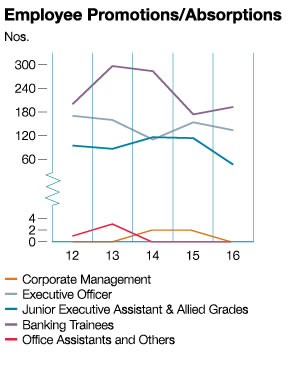
Graph 39
An Engaged Team
The Bank engages with its employees through formal (hard copy, email etc.) and informal communication channels. Key information communicated through formal channels mainly relate to the Bank’s vision, strategic goals, values and significant changes in policies or governance structures. All manuals including the Code of Ethics are available on the intranet site of the Bank and also in hard copy for reference when required. Regular meetings within strategic business units also form a vital link in formal channels of communication. Notice boards at key locations also serve to reinforce key messages.
Informal engagement is encouraged through recreational events organised at strategic business unit level, regional level and for the country. These events include annual trips for employees and their families, celebration of festivals and sports tournaments where employees compete with friendly camaraderie. Employee participation levels at these events are high and the Bank makes a substantial contribution to subsidise the cost of these events.
Freedom of Association and Collective Bargaining
The Bank recognises its employees’ rights to freedom of association and collective bargaining and maintains healthy relationships with its employee associations, the Commercial Bank Executive Association (CBEA) and the Ceylon Bank Employees Union (CBEU) having regular dialogue and giving due consideration when formulating the relevant policies and procedures (graph 40). A collective agreement is in place with the Ceylon Bank Employees Union including salaries and other perquisites, staff loans and provision of accommodation for staff who are placed in locations away from their home stations etc. Minimum notice periods are observed for changes (Table 11) in any of the terms set out in the collective agreements as inset.
| Type of Change | Minimum Notice Period |
| Collective Bargaining | 36 weeks |
| Transfers | 2 weeks |
| Terminations | 4-12 weeks |
| Retirements | 3-4 weeks |
| Dismissals | Immediate |
| Voluntary Resignation Schemes | As specified in scheme |
Table 11

Graph 40
Dignity, Health and Safety
Human Rights
The Bank’s Code of Ethics and a comprehensive policy framework seek to nurture a culture of respect for human rights and values and are based on the UN Global Compact principles and the Universal Declaration of Human Rights proclaimed by the UN. Our Human Resource Department, business line heads, departmental heads and branch managers are trained and held responsible for upholding human rights. The Bank’s Inspection Department also verifies compliance with the policy framework on a regular basis. Consequently, 89% of employees are members of trade unions with whom the Bank has good relations and there is zero tolerance for child labour, compulsory labour, harassment or discrimination in the workplace.
The Whistle-Blower Charter empowers employees to report on potential human rights violations which are investigated promptly with disciplinary action taken on violators which may include dismissal.
There have been no incidents of Human Rights violation reported during the year under review.
Health and Safety
All permanent employees are covered under a comprehensive medical insurance scheme for both in-house medical treatment and reimbursement of outpatient medical costs. The collective agreements provide for the Bank to reimburse expense of a full medical check-up upon reaching the age of 35 years.
Our Bank branches are equipped with alarm systems, CCTV cameras and trained security personnel have been deployed to ensure the safety of our people and our clients. The Bank’s Security Department conduct training programmes for our people including fire drills and responding to various threats and have identified dedicated teams within each business/service units of the Bank to supplement its work. These champions are provided comprehensive training on how to respond to emergencies such as fire, robberies and natural disasters. No significant health and safety issues were reported during the year.
Grievances
The Bank has a ‘Speak Out’ web portal where employees are encouraged to air their concerns regarding working conditions, labour practices or potential violations of human rights. This is monitored by the HR Department and legitimate concerns raised are investigated and action taken accordingly. An open door policy initiates more immediate discussions enabling early identification and resolution of issues. This proactive approach has ensured that there were no grievances relating to labour practices filed at the Bank.
